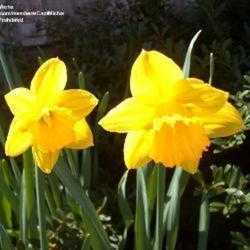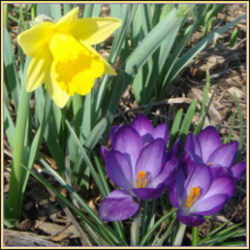(Editor's Note: This article was originally published on April 25, 2009. Your comments are welcome, but please be aware that authors of previously published articles may not be able to respond to your questions.)
Daffodils, crocus, hyacinths- spring bulbs like these put on a glorious show for a few weeks a year. Having just enjoyed the colorful display, many home gardeners wonder about how to best put spring bulbs to bed for the summer. Here are the answers to frequently asked questions regarding bulb care in late spring.
Au revoir, "Tête à Tête" daffodils !
Can I cut off the leaves? No.
Leaves are appropriately named in this case because you should leave them on the plants as long as they appear green and vital. Those leaves are the factory making energy to rebuild this year's bulb and create next year's blossom. Some weeks after the current blooms fade, the foliage will have finished its work and will begin to turn yellow and die down. This is the plant's normal cycle.
Can I hide those leaves while they finish dying down? Yes.
.
Declining bulb greenery can become pretty messy looking. A well planned planting scheme helps mitigate the unsightliness of collapsing bulb tops. Use plant selections whose emerging foliage blocks your view of yellowing bulb tops. Or make your bulb plantings in a groundcover bed. Fainting foliage from the bulbs will pass out right into a comfy bed of groundcover and become part of the mulch. Daffodils in particular have tall leaves that last a long time. Where neatness really counts, some gardeners tidy up daffodil leaves like a mother ponytailing her daughter's stray locks. Sprawling daffodil foliage can be gently and loosely braided or bundled so it can finish reforming the underlying bulbs. In general though, allow spring bulb leaves to complete their life cycle naturally for best bulb health.
Unknown cultivar of narcissus with Geranium macrorrhizum and Aquilegia.  The bulb foliage will die down and be hidden in the perennials as they grow
The bulb foliage will die down and be hidden in the perennials as they grow
Do I remove seedpods and spent blooms? Maybe.
Cutting pods off of spring bulbs is a choice depending on the bulb in question and the kind of planting in which it's used. The Netherlands Flower Bulb Information Center advises cutting seed heads off of tulips and Dutch hyacinths. Seed formation of most other spring bulbs either helps propagate the bulb or simply does no harm. In formal beds, removing spent blooms may help tidy things up. For casual, naturalized bulbs plantings, you may allow seeds to form. Some smaller bulbs such as Chionodoxa, Eranthis and Scilla, can self-sow, so you'll get a faster return on your investment by letting them go to seed.
Few gardeners collect bulb seeds. Seeds of hybrid flowering bulbs may not produce identical plants, and it will take several years to know if they have. If you want more bulbs, you are better off giving the existing plantings good care and using sets that they produce by dividing them. Also, understand that removal of spent blooms from bulbs does not prolong flowering that way it does for annuals. Bulb flowering is a one shot deal each year.
Should I fertilize? No.
Granular fertilizers applied to surface soil now won't reach the bulb roots in time to do any good. If fertilizer is needed, it should be applied to the surface above the bulbs in the fall. If you are moving bulbs in spring or summer, you can add a gentle fertilizer or compost to the planting hole.
Can I move or divide them now? Yes.
Once bulb foliage begins to die down, spring bulbs have gone dormant for the summer. Many gardeners like to use this window of time for moving or dividing bulbs. Having wilted foliage on the bulbs you are working with gives you a handy depth gauge for replanting. Having wilted bulb foliage elsewhere in the garden provides a ready reference for placing new or relocated bulbs. For the truly brown- thumbed, leaves attached to bulbs assures planting with the right end up! Sort through the bulbs you dig, replanting only an appropriate number of the largest in the same spot. Plant additional good-sized bulbs elsewhere in your landscape or share them. Smaller new bulbs can be used but may need more years to grow to blooming size. When replanting, boost your bulbs with some gentle organic fertilizer or compost mixed into the planting area. A slow-release source of phophorous, the P component of N-P-K, should go down below the bulbs if possible.
You may also dig bulbs at this time for storage until fall. Shake off the soil, allow bulbs to dry well, remove crispy leaves and  store the bulbs in a dry location until fall.
store the bulbs in a dry location until fall.
How do I know if my bulbs need to be divided? Loads of leaves, few flowers.
Happy bulbs will flower each year and produce small side bulbs. The newer shoots use nutrients in the soil, and must make leaves before they can flower themselves. At some point, there are so many roots competing for resources in one small area that while you see lots of greenery, few flowers are formed. That's a sign that you need to dig up the patch of bulbs for renewal.
This clump of daffodils could easily contain a dozen bulbs, but only two flowers were produced. The scant flowering was probably due to crowding and low soil fertility.
Can I plant other flowers on top of bulbs? Maybe.
Larger flowers like tulip, daffodil and hyacinth usually come from bigger bulbs that live about eight inches down in the soil. Go ahead and plant small annuals around and even on top of those bulb plantings, just taking care that you don't dig very deeply and cut into the bulbs. Small bulbs such as crocus and snowdrops will be closer to the surface and you must use care not to dig them up. You could dig between the clumps if you have marked their location, or grow annuals from seed in the same bed. Perennials can be grown among bulbs, but you'll want to place those plants between bulb clumps and not directly on top. That way you can access each for the upkeep (read: unexpected fall bulb swapping!) they'll need at different times.
Am I guaranteed reblooming spring bulbs with these tips? No.
Some species like daffodil and crocus are generally reliable rebloomers. Others such as tulips often fade quickly in the home garden. And within a species, there is variation. Success with bulbs that flower year after year comes not only with proper care, but by choosing varieties or species that are often recommended for naturalizing or perennializing.
| Tulip varieties | Darwin hybrids, Emperors |
Daffodil cultivars [1] | Ice Follies, Tete-a-Tete, Flower Record, Delibes, Unsurpassable, Barrett Browning, Scarlet Gem, Geranium, Cheerfulness, Peeping Tom, Mount Hood, Spellbinder, Carlton, and Viking. |
| other bulb species | crocus, bluebells (Hyacinthoides), grape hyacinth (Muscari), snowdrops (Galanthus), wild hyacinth (Camassia) |
[1] American Daffodil Society
~@~ ~@~ ~@~
Be sure to look for other articles in our Spring Bulb Theme Week, April 21 through 28, 2009.
Previous related Dave's Garden articles
Daffodils and companions: Dig less, plant more! for a fabulous spring flower display by Jill M. Nicolaus
Daffodils by Gloria Cole
Bulb Lovers Unite: A Year of Bloom by Toni Leland
The Dutch Bulb Fields and Tulipomania by Dutchlady1
Trout Lilies, Fawn Lilies and Dog's-Tooth Violets - The Elegant Erythroniums by Todd Boland
The Springtime Blues - Grape Hyacinths by Todd Boland
The tête-à-tête daffodil - enjoy it twice, once in a pot and forever in your garden! by Carrie Lamont
The Netherlands Flower Bulb Information Center/ North America
Dr Leonard Perry Extension Professor, University of Vermont, Spring Bulbs After Bloom
Bradley, Fern Marshall and Barbara W. Ellis, eds. Rodale's All-New Encyclopedia of Organic Gardening. Emmaus, Rodale Pres, 1997.Pictures were taken by and are property of the author, who sometimes has a little too much help with digging and dividing her bulbs.


















